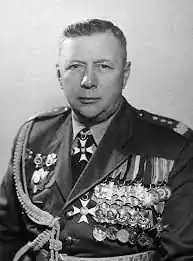Jerzy Bordziłowsky | |
|---|---|
 | |
| Born | 16 November 1900 Ostrów Mazowiecka, Russian Empire |
| Died | 5 April 1983 (aged 82) Moscow, Russian SFSR, Soviet Union |
| Buried | |
| Allegiance | Soviet Union Polish People's Republic |
| Service/ | Red Army (1919–1944) Polish People's Army (1944–1945) |
| Years of service | 1919–1983 |
| Rank | |
| Commands held | Polish General Staff |
| Battles/wars | Polish-Soviet War World War II |
Jerzy Bordziłowski (Russian: Юрий Вячеславович Бордзиловский; 16 November 1900 – 5 April 1983) was a Polish and Soviet military officer and communist politician.
Biography
Born in Ostrów Mazowiecka to a Polish doctor serving in the Russian Imperial Army, he spent his childhood in Kherson. In 1919 he joined the Red Army and fought against Poland during the Polish-Bolshevist War and in the Russian Civil War. After the outbreak of Nazi-Soviet War he was promoted to the rank of Colonel and became the chief inspector of engineers and sappers of the 21st Army. He took part in the Battle of Stalingrad and in September 1942 was promoted to the rank of General and became the deputy commanding officer of the Voronezh Front.
On 24 September 1944 he was dispatched by his Soviet superiors to join the Polish Army along with a number of high-ranking Soviet officers of Polish extraction. He commanded all engineering troops of the First Polish Army. Shortly after World War II ended, on 11 July 1945, he was promoted to the rank of Lieutenant General,[1] and became the head of engineering troops of the Polish Armed Forces.
In that capacity he was also the president of Legia Warsaw sports club. On 23 March 1954 he became the Chief of General Staff and deputy Minister of National Defence. In that capacity he was responsible for the bloody quelling of the Poznań 1956 protests. Between 1952 and 1956 he was also briefly a member of the façade Sejm. In March 1968 he was recalled back to the USSR and spent the remainder of his career at various high-ranking posts in the Soviet Army. He died 5 April 1983 in Moscow and was buried at the Kuntsevo Cemetery.
References
- ↑ "Постановление СНК СССР от 11.07.1945 N 1683" [Decree of the SNK SSSR of 11 July 1945 No. 1683] (in Russian). 11 July 1945. Retrieved 15 April 2020.